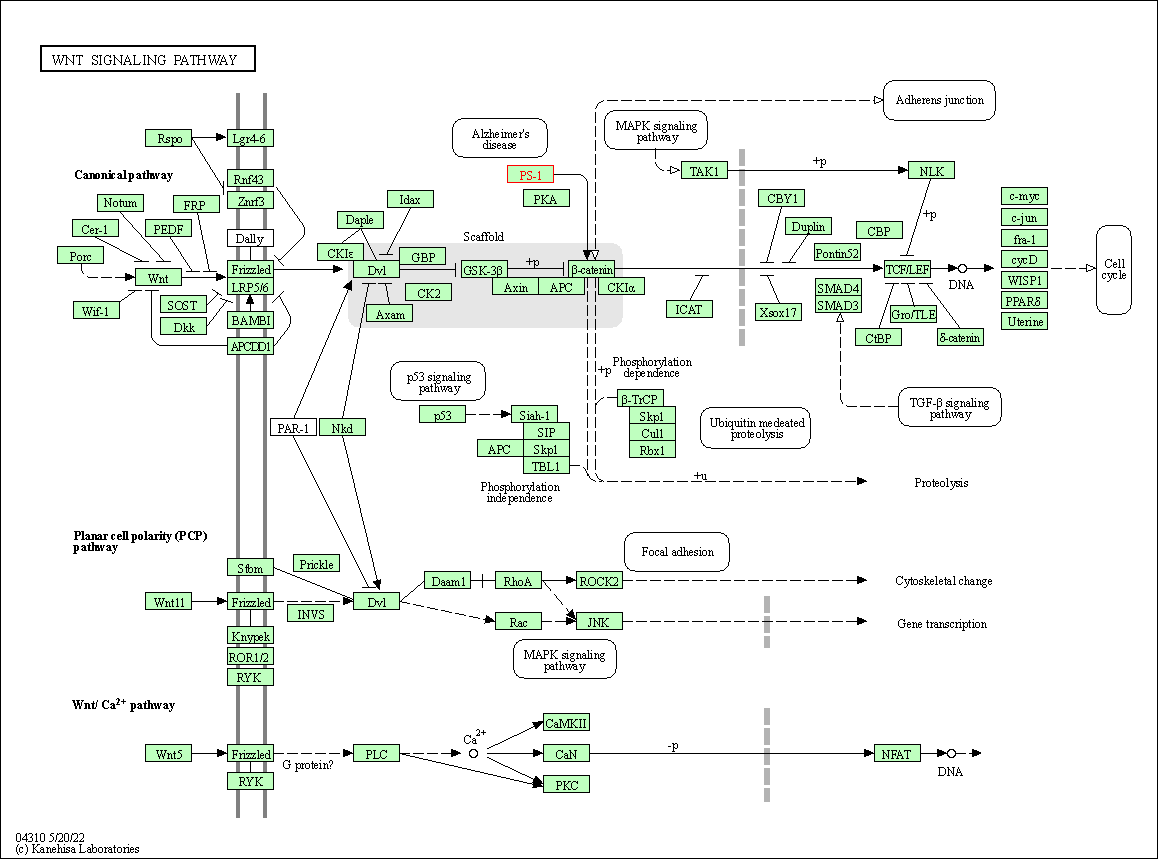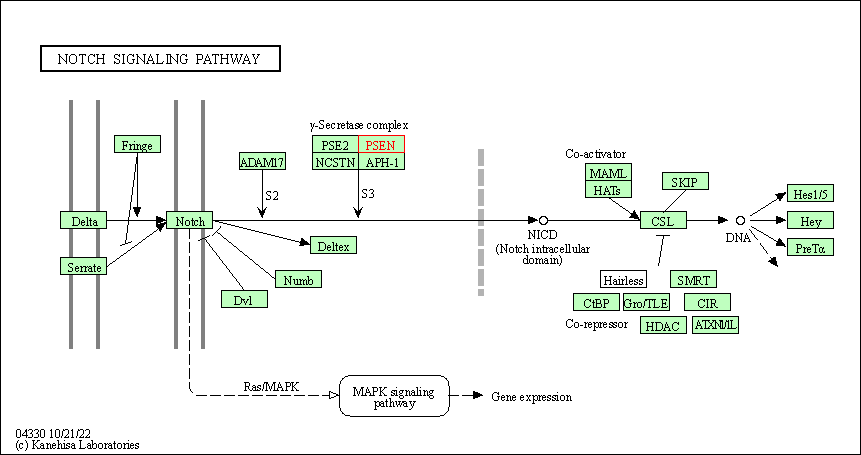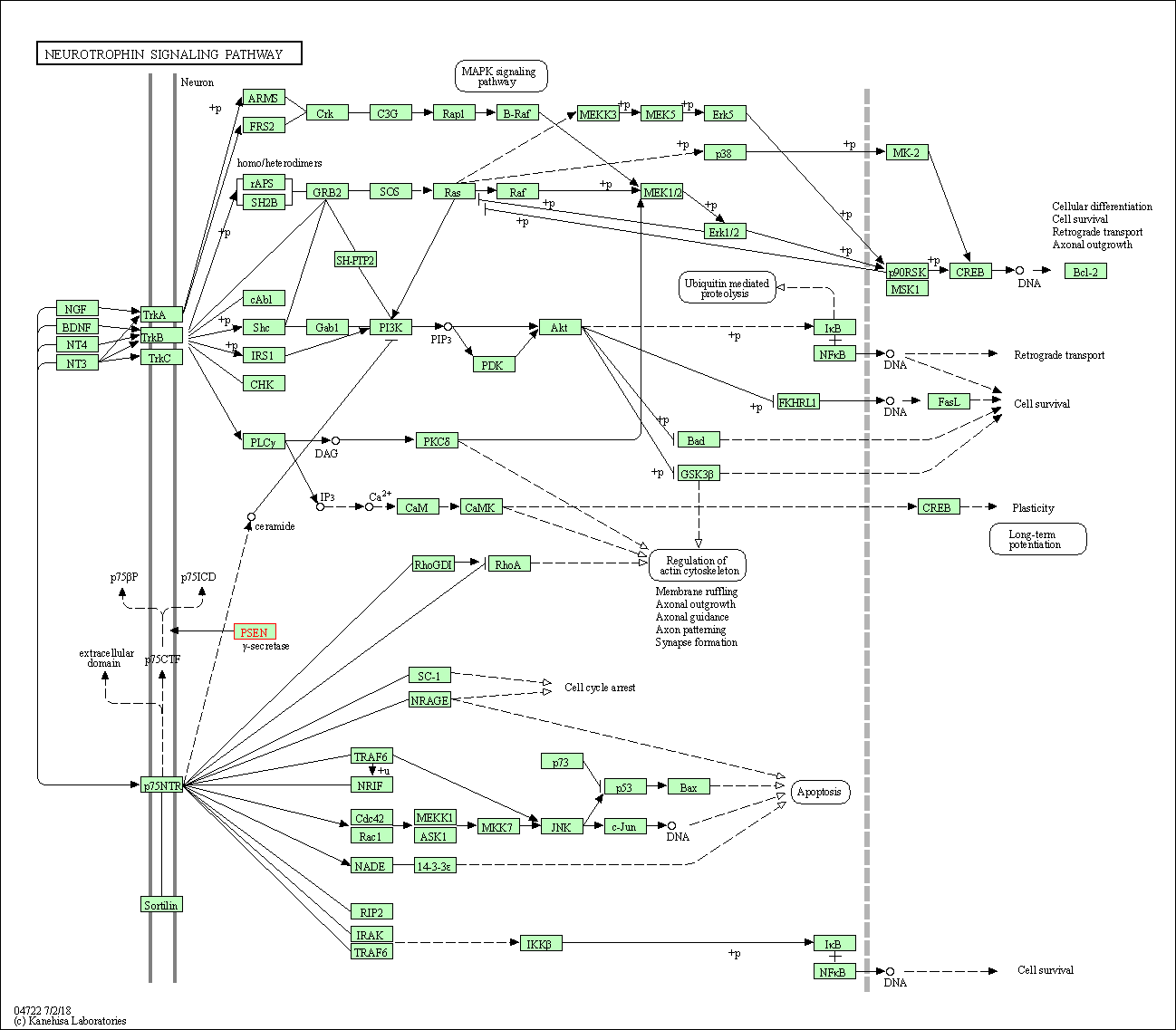Target Information
| Target General Information | Top | |||||
|---|---|---|---|---|---|---|
| Target ID |
T93105
(Former ID: TTDR00444)
|
|||||
| Target Name |
Presenilin 1 (PSEN1)
|
|||||
| Synonyms |
S182 protein; Protein S182; Presenilin-1; PSNL1; PS1; PS-1; AD3
Click to Show/Hide
|
|||||
| Gene Name |
PSEN1
|
|||||
| Target Type |
Clinical trial target
|
[1] | ||||
| Disease | [+] 3 Target-related Diseases | + | ||||
| 1 | Osteoarthritis [ICD-11: FA00-FA05] | |||||
| 2 | Shoulder lesion [ICD-11: FB53] | |||||
| 3 | Soft tissue disorder [ICD-11: FB56] | |||||
| Function |
Requires the presence of the other members of the gamma-secretase complex for protease activity. Plays a role in Notch and Wnt signaling cascades and regulation of downstream processes via its role in processing key regulatory proteins, and by regulating cytosolic CTNNB1 levels. Stimulates cell-cell adhesion via its interaction with CDH1; this stabilizes the complexes between CDH1 (E-cadherin) and its interaction partners CTNNB1 (beta-catenin), CTNND1 and JUP (gamma-catenin). Under conditions of apoptosis or calcium influx, cleaves CDH1. This promotes the disassembly of the complexes between CDH1 and CTNND1, JUP and CTNNB1, increases the pool of cytoplasmic CTNNB1, and thereby negatively regulates Wnt signaling. Required for normal embryonic brain and skeleton development, and for normal angiogenesis. Mediates the proteolytic cleavage of EphB2/CTF1 into EphB2/CTF2. The holoprotein functions as a calcium-leak channel that allows the passive movement of calcium from endoplasmic reticulum to cytosol and is therefore involved in calcium homeostasis. Involved in the regulation of neurite outgrowth. Is a regulator of presynaptic facilitation, spike transmission and synaptic vesicles replenishment in a process that depends on gamma-secretase activity. It acts through the control of SYT7 presynaptic expression. Catalytic subunit of the gamma-secretase complex, an endoprotease complex that catalyzes the intramembrane cleavage of integral membrane proteins such as Notch receptors and APP (amyloid-beta precursor protein).
Click to Show/Hide
|
|||||
| BioChemical Class |
Peptidase
|
|||||
| UniProt ID | ||||||
| EC Number |
EC 3.4.23.-
|
|||||
| Sequence |
MTELPAPLSYFQNAQMSEDNHLSNTVRSQNDNRERQEHNDRRSLGHPEPLSNGRPQGNSR
QVVEQDEEEDEELTLKYGAKHVIMLFVPVTLCMVVVVATIKSVSFYTRKDGQLIYTPFTE DTETVGQRALHSILNAAIMISVIVVMTILLVVLYKYRCYKVIHAWLIISSLLLLFFFSFI YLGEVFKTYNVAVDYITVALLIWNFGVVGMISIHWKGPLRLQQAYLIMISALMALVFIKY LPEWTAWLILAVISVYDLVAVLCPKGPLRMLVETAQERNETLFPALIYSSTMVWLVNMAE GDPEAQRRVSKNSKYNAESTERESQDTVAENDDGGFSEEWEAQRDSHLGPHRSTPESRAA VQELSSSILAGEDPEERGVKLGLGDFIFYSVLVGKASATASGDWNTTIACFVAILIGLCL TLLLLAIFKKALPALPISITFGLVFYFATDYLVQPFMDQLAFHQFYI Click to Show/Hide
|
|||||
| 3D Structure | Click to Show 3D Structure of This Target | PDB | ||||
| HIT2.0 ID | T28HCY | |||||
| Drugs and Modes of Action | Top | |||||
|---|---|---|---|---|---|---|
| Clinical Trial Drug(s) | [+] 1 Clinical Trial Drugs | + | ||||
| 1 | (S)-FLURBIPROFEN | Drug Info | Preregistration | Myalgia | [2] | |
| Mode of Action | [+] 1 Modes of Action | + | ||||
| Inhibitor | [+] 11 Inhibitor drugs | + | ||||
| 1 | (S)-FLURBIPROFEN | Drug Info | [1] | |||
| 2 | R-flurbiprofen | Drug Info | [1] | |||
| 3 | (2S,3R)-2-(benzyloxy)-3-methoxycyclohexanone | Drug Info | [3] | |||
| 4 | (5R,6S)-5,6-bis(benzyloxy)cyclohex-2-enone | Drug Info | [3] | |||
| 5 | (5R,6S)-6-(benzyloxy)-5-methoxycyclohex-2-enone | Drug Info | [3] | |||
| 6 | 1-benzoyl-2-benzyl-1,2-dihydropyridin-3(6H)-one | Drug Info | [3] | |||
| 7 | 1-Chloro-4-(1-phenyl-cyclohexanesulfonyl)-benzene | Drug Info | [4] | |||
| 8 | Drug 311383 | Drug Info | [5] | |||
| 9 | Drug 311440 | Drug Info | [5] | |||
| 10 | Drug 311951 | Drug Info | [5] | |||
| 11 | Drug 311952 | Drug Info | [5] | |||
| Cell-based Target Expression Variations | Top | |||||
|---|---|---|---|---|---|---|
| Cell-based Target Expression Variations | ||||||
| Drug Binding Sites of Target | Top | |||||
|---|---|---|---|---|---|---|
| Ligand Name: Semagacestat | Ligand Info | |||||
| Structure Description | Molecular basis for inhibition of human gamma-secretase by small molecule | PDB:6LR4 | ||||
| Method | Electron microscopy | Resolution | 3.00 Å | Mutation | No | [6] |
| PDB Sequence |
LKYGAKHVIM
84 LFVPVTLCMV94 VVVATIKSVS104 FYTRKDGQLI114 YTPFTEDTET124 VGQRALHSIL 134 NAAIMISVIV144 VMTILLVVLY154 KYRCYKVIHA164 WLIISSLLLL174 FFFSFIYLGE 184 VFKTYNVAVD194 YITVALLIWN204 FGVVGMISIH214 WKGPLRLQQA224 YLIMISALMA 234 LVFIKYLPEW244 TAWLILAVIS254 VYDLVAVLCP264 KGPLRMLVET274 AQERNETLFP 284 ALIYSSTRGV379 KLGLGDFIFY389 SVLVGKASAT399 ASGDWNTTIA409 CFVAILIGLC 419 LTLLLLAIFK429 KALPALPISI439 TFGLVFYFAT449 DYLVQPFMDQ459 LAFHQFYI |
|||||
|
|
TYR77
4.363
ASP257
4.984
VAL261
4.865
LEU268
4.750
VAL272
4.147
GLN276
4.238
LEU282
3.871
ILE287
4.137
GLY378
4.644
VAL379
3.611
LYS380
3.229
|
|||||
| Ligand Name: BMS-708163 | Ligand Info | |||||
| Structure Description | Human gamma-secretase in complex with small molecule Avagacestat | PDB:6LQG | ||||
| Method | Electron microscopy | Resolution | 3.10 Å | Mutation | No | [6] |
| PDB Sequence |
LKYGAKHVIM
84 LFVPVTLCMV94 VVVATIKSVS104 FYTRKDGQLI114 YTPFTEDTET124 VGQRALHSIL 134 NAAIMISVIV144 VMTILLVVLY154 KYRCYKVIHA164 WLIISSLLLL174 FFFSFIYLGE 184 VFKTYNVAVD194 YITVALLIWN204 FGVVGMISIH214 WKGPLRLQQA224 YLIMISALMA 234 LVFIKYLPEW244 TAWLILAVIS254 VYDLVAVLCP264 KGPLRMLVET274 AQERNETLFP 284 ALIYSSTERG378 VKLGLGDFIF388 YSVLVGKASA398 TASGDWNTTI408 ACFVAILIGL 418 CLTLLLLAIF428 KKALPALPIS438 ITFGLVFYFA448 TDYLVQPFMD458 QLAFHQFYI |
|||||
|
|
LEU85
4.484
VAL261
3.804
LEU268
3.248
VAL272
3.262
ALA275
4.489
GLN276
3.540
GLU280
4.454
LEU282
4.360
VAL379
4.514
LYS380
3.164
LEU381
3.597
|
|||||
| Click to View More Binding Site Information of This Target with Different Ligands | ||||||
| Different Human System Profiles of Target | Top |
|---|---|
|
Human Similarity Proteins
of target is determined by comparing the sequence similarity of all human proteins with the target based on BLAST. The similarity proteins for a target are defined as the proteins with E-value < 0.005 and outside the protein families of the target.
A target that has fewer human similarity proteins outside its family is commonly regarded to possess a greater capacity to avoid undesired interactions and thus increase the possibility of finding successful drugs
(Brief Bioinform, 21: 649-662, 2020).
Human Tissue Distribution
of target is determined from a proteomics study that quantified more than 12,000 genes across 32 normal human tissues. Tissue Specificity (TS) score was used to define the enrichment of target across tissues.
The distribution of targets among different tissues or organs need to be taken into consideration when assessing the target druggability, as it is generally accepted that the wider the target distribution, the greater the concern over potential adverse effects
(Nat Rev Drug Discov, 20: 64-81, 2021).
Human Pathway Affiliation
of target is determined by the life-essential pathways provided on KEGG database. The target-affiliated pathways were defined based on the following two criteria (a) the pathways of the studied target should be life-essential for both healthy individuals and patients, and (b) the studied target should occupy an upstream position in the pathways and therefore had the ability to regulate biological function.
Targets involved in a fewer pathways have greater likelihood to be successfully developed, while those associated with more human pathways increase the chance of undesirable interferences with other human processes
(Pharmacol Rev, 58: 259-279, 2006).
Biological Network Descriptors
of target is determined based on a human protein-protein interactions (PPI) network consisting of 9,309 proteins and 52,713 PPIs, which were with a high confidence score of ≥ 0.95 collected from STRING database.
The network properties of targets based on protein-protein interactions (PPIs) have been widely adopted for the assessment of target’s druggability. Proteins with high node degree tend to have a high impact on network function through multiple interactions, while proteins with high betweenness centrality are regarded to be central for communication in interaction networks and regulate the flow of signaling information
(Front Pharmacol, 9, 1245, 2018;
Curr Opin Struct Biol. 44:134-142, 2017).
Human Similarity Proteins
Human Tissue Distribution
Human Pathway Affiliation
Biological Network Descriptors
|
|
|
There is no similarity protein (E value < 0.005) for this target
|
|
Note:
If a protein has TS (tissue specficity) scores at least in one tissue >= 2.5, this protein is called tissue-enriched (including tissue-enriched-but-not-specific and tissue-specific). In the plots, the vertical lines are at thresholds 2.5 and 4.
|
| KEGG Pathway | Pathway ID | Affiliated Target | Pathway Map |
|---|---|---|---|
| Wnt signaling pathway | hsa04310 | Affiliated Target |

|
| Class: Environmental Information Processing => Signal transduction | Pathway Hierarchy | ||
| Notch signaling pathway | hsa04330 | Affiliated Target |

|
| Class: Environmental Information Processing => Signal transduction | Pathway Hierarchy | ||
| Neurotrophin signaling pathway | hsa04722 | Affiliated Target |

|
| Class: Organismal Systems => Nervous system | Pathway Hierarchy | ||
| Degree | 23 | Degree centrality | 2.47E-03 | Betweenness centrality | 3.97E-03 |
|---|---|---|---|---|---|
| Closeness centrality | 2.44E-01 | Radiality | 1.43E+01 | Clustering coefficient | 1.30E-01 |
| Neighborhood connectivity | 3.11E+01 | Topological coefficient | 6.59E-02 | Eccentricity | 12 |
| Download | Click to Download the Full PPI Network of This Target | ||||
| Chemical Structure based Activity Landscape of Target | Top |
|---|---|
| Drug Property Profile of Target | Top | |
|---|---|---|
| (1) Molecular Weight (mw) based Drug Clustering | (2) Octanol/Water Partition Coefficient (xlogp) based Drug Clustering | |
|
|
||
| (3) Hydrogen Bond Donor Count (hbonddonor) based Drug Clustering | (4) Hydrogen Bond Acceptor Count (hbondacc) based Drug Clustering | |
|
|
||
| (5) Rotatable Bond Count (rotbonds) based Drug Clustering | (6) Topological Polar Surface Area (polararea) based Drug Clustering | |
|
|
||
| "RO5" indicates the cutoff set by lipinski's rule of five; "D123AB" colored in GREEN denotes the no violation of any cutoff in lipinski's rule of five; "D123AB" colored in PURPLE refers to the violation of only one cutoff in lipinski's rule of five; "D123AB" colored in BLACK represents the violation of more than one cutoffs in lipinski's rule of five | ||
| Target Poor or Non Binders | Top | |||||
|---|---|---|---|---|---|---|
| Target Poor or Non Binders | ||||||
| Target Regulators | Top | |||||
|---|---|---|---|---|---|---|
| Target-regulating microRNAs | ||||||
| Target-interacting Proteins | ||||||
| Target Affiliated Biological Pathways | Top | |||||
|---|---|---|---|---|---|---|
| KEGG Pathway | [+] 4 KEGG Pathways | + | ||||
| 1 | Wnt signaling pathway | |||||
| 2 | Notch signaling pathway | |||||
| 3 | Neurotrophin signaling pathway | |||||
| 4 | Alzheimer's disease | |||||
| NetPath Pathway | [+] 1 NetPath Pathways | + | ||||
| 1 | Notch Signaling Pathway | |||||
| Panther Pathway | [+] 3 Panther Pathways | + | ||||
| 1 | Alzheimer disease-amyloid secretase pathway | |||||
| 2 | Alzheimer disease-presenilin pathway | |||||
| 3 | Notch signaling pathway | |||||
| PID Pathway | [+] 4 PID Pathways | + | ||||
| 1 | Notch signaling pathway | |||||
| 2 | Presenilin action in Notch and Wnt signaling | |||||
| 3 | p75(NTR)-mediated signaling | |||||
| 4 | Syndecan-3-mediated signaling events | |||||
| Reactome | [+] 1 Reactome Pathways | + | ||||
| 1 | Degradation of the extracellular matrix | |||||
| WikiPathways | [+] 3 WikiPathways | + | ||||
| 1 | Notch Signaling Pathway | |||||
| 2 | Notch Signaling Pathway | |||||
| 3 | Alzheimers Disease | |||||
| Target-Related Models and Studies | Top | |||||
|---|---|---|---|---|---|---|
| Target Validation | ||||||
| References | Top | |||||
|---|---|---|---|---|---|---|
| REF 1 | The geminal dimethyl analogue of Flurbiprofen as a novel Abeta42 inhibitor and potential Alzheimer's disease modifying agent. Bioorg Med Chem Lett. 2006 Apr 15;16(8):2219-23. | |||||
| REF 2 | Trusted, scientifically sound profiles of drug programs, clinical trials, safety reports, and company deals, written by scientists. Springer. 2015. Adis Insight (drug id 800025057) | |||||
| REF 3 | Novel gamma-secretase inhibitors discovered by library screening of in-house synthetic natural product intermediates. Bioorg Med Chem Lett. 2006 Jul 15;16(14):3813-6. | |||||
| REF 4 | Aryl sulfones: a new class of gamma-secretase inhibitors. Bioorg Med Chem Lett. 2005 May 16;15(10):2685-8. | |||||
| REF 5 | Discovery of a Subnanomolar helical D-tridecapeptide inhibitor of gamma-secretase. J Med Chem. 2004 Jul 29;47(16):3931-3. | |||||
| REF 6 | Structural basis of Gamma-secretase inhibition and modulation by small molecule drugs. Cell. 2021 Jan 21;184(2):521-533.e14. | |||||
If You Find Any Error in Data or Bug in Web Service, Please Kindly Report It to Dr. Zhou and Dr. Zhang.

